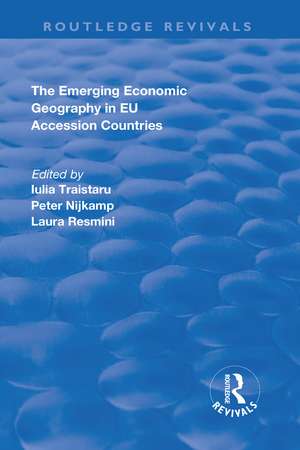The Emerging Economic Geography in EU Accession Countries: Routledge Revivals
Autor Peter Nijkamp Editat de Iulia Traistaruen Limba Engleză Hardback – 22 noi 2017
| Toate formatele și edițiile | Preț | Express |
|---|---|---|
| Paperback (1) | 216.07 lei 6-8 săpt. | |
| Taylor & Francis – 11 noi 2019 | 216.07 lei 6-8 săpt. | |
| Hardback (1) | 473.94 lei 6-8 săpt. | |
| Taylor & Francis – 22 noi 2017 | 473.94 lei 6-8 săpt. |
Din seria Routledge Revivals
- 9%
 Preț: 801.69 lei
Preț: 801.69 lei - 8%
 Preț: 432.15 lei
Preț: 432.15 lei -
 Preț: 153.81 lei
Preț: 153.81 lei -
 Preț: 230.80 lei
Preț: 230.80 lei -
 Preț: 294.72 lei
Preț: 294.72 lei -
 Preț: 258.72 lei
Preț: 258.72 lei - 9%
 Preț: 764.34 lei
Preț: 764.34 lei - 9%
 Preț: 903.41 lei
Preț: 903.41 lei -
 Preț: 296.10 lei
Preț: 296.10 lei -
 Preț: 342.36 lei
Preț: 342.36 lei - 9%
 Preț: 606.35 lei
Preț: 606.35 lei -
 Preț: 317.54 lei
Preț: 317.54 lei - 9%
 Preț: 764.28 lei
Preț: 764.28 lei -
 Preț: 257.00 lei
Preț: 257.00 lei -
 Preț: 238.40 lei
Preț: 238.40 lei -
 Preț: 259.47 lei
Preț: 259.47 lei - 9%
 Preț: 903.80 lei
Preț: 903.80 lei -
 Preț: 326.26 lei
Preț: 326.26 lei -
 Preț: 258.66 lei
Preț: 258.66 lei -
 Preț: 294.97 lei
Preț: 294.97 lei -
 Preț: 308.89 lei
Preț: 308.89 lei -
 Preț: 199.85 lei
Preț: 199.85 lei -
 Preț: 347.49 lei
Preț: 347.49 lei -
 Preț: 295.04 lei
Preț: 295.04 lei -
 Preț: 389.39 lei
Preț: 389.39 lei -
 Preț: 257.00 lei
Preț: 257.00 lei -
 Preț: 343.21 lei
Preț: 343.21 lei - 9%
 Preț: 640.90 lei
Preț: 640.90 lei - 9%
 Preț: 619.48 lei
Preț: 619.48 lei -
 Preț: 228.88 lei
Preț: 228.88 lei -
 Preț: 257.67 lei
Preț: 257.67 lei -
 Preț: 245.10 lei
Preț: 245.10 lei -
 Preț: 258.52 lei
Preț: 258.52 lei -
 Preț: 258.72 lei
Preț: 258.72 lei -
 Preț: 368.93 lei
Preț: 368.93 lei -
 Preț: 246.37 lei
Preț: 246.37 lei - 9%
 Preț: 832.07 lei
Preț: 832.07 lei -
 Preț: 258.66 lei
Preț: 258.66 lei -
 Preț: 286.98 lei
Preț: 286.98 lei - 18%
 Preț: 695.85 lei
Preț: 695.85 lei - 9%
 Preț: 934.94 lei
Preț: 934.94 lei - 5%
 Preț: 231.22 lei
Preț: 231.22 lei -
 Preț: 267.15 lei
Preț: 267.15 lei -
 Preț: 200.66 lei
Preț: 200.66 lei - 9%
 Preț: 638.61 lei
Preț: 638.61 lei -
 Preț: 259.68 lei
Preț: 259.68 lei - 9%
 Preț: 1038.45 lei
Preț: 1038.45 lei -
 Preț: 389.43 lei
Preț: 389.43 lei -
 Preț: 302.13 lei
Preț: 302.13 lei -
 Preț: 294.72 lei
Preț: 294.72 lei
Preț: 473.94 lei
Preț vechi: 612.85 lei
-23% Nou
Puncte Express: 711
Preț estimativ în valută:
90.69€ • 94.68$ • 75.06£
90.69€ • 94.68$ • 75.06£
Carte tipărită la comandă
Livrare economică 04-18 aprilie
Preluare comenzi: 021 569.72.76
Specificații
ISBN-13: 9781138711822
ISBN-10: 1138711829
Pagini: 480
Dimensiuni: 154 x 234 mm
Greutate: 0.45 kg
Ediția:1
Editura: Taylor & Francis
Colecția Routledge
Seria Routledge Revivals
Locul publicării:Oxford, United Kingdom
ISBN-10: 1138711829
Pagini: 480
Dimensiuni: 154 x 234 mm
Greutate: 0.45 kg
Ediția:1
Editura: Taylor & Francis
Colecția Routledge
Seria Routledge Revivals
Locul publicării:Oxford, United Kingdom
Cuprins
Contents: Part I: Analytical Framework: Spatial implications of economic integration in EU accession countries, Laura Resmini and Iulia Traistaru; European integration, regional specialization and location of industrial activity: a survey of theoretical and empirical literature, Peter Nijkamp, Laura Resmini and Iulia Traistaru; Data and measurement, Iulia Traistaru and Anna Iara. Part II: Country Studies: The emerging economic geography in Bulgaria, Julia Spiridonova; The emerging economic geography in Estonia, Grigory Fainshtein and Natalie Lubenets; The emerging economic geography in Hungary, Alessandro Maffioli; The emerging economic geography in Romania, Iulia Traistaru and Carmen Pauna; The emerging economic geography in Slovenia, Joze P. Damijan and Èrt Kostevc. Part III: Comparative Analysis and Lessons: Specialization of regions and concentration of industries in EU accession countries, Iulia Traistaru, Peter Nijkamp and Simonetta Longhi; The impact of European integration on the adjustment pattern of regional wages in accession countries, Joze P. Damijan and Èrt Kostevc; The implications of European integration and adjustment for border regions in accession countries, Laura Resmini; The emerging economic geography in EU accession countries: concluding remarks and policy implications, Iulia Traistaru, Peter Nijkamp and Laura Resmini; Index.
Notă biografică
Iulia Traistaru is a Senior Research Fellow at the Center for European Integration Studies (ZEI) at the University of Bonn, Germany. Peter Nijkamp is a Professor within the Department of Spatial Economics at the Free University of Amsterdam, The Netherlands. Laura Resmini is a Lecturer at the Institute of Economics at the University "Luigi Bocconi", Milan, Italy.
Recenzii
'A very important book that covers new ground on the spatial implications of economic integration in Eastern European accession countries. It represents applied regional economics at its very best, an absolutely essential reading for serious students and scholars in European Integration.' Professor Manfred M. Fischer, University of Economics and Business Administration, Vienna. 'This is a valuable book shedding light into the spatial implications of East-West integration in Europe. It is a requirement for policy makers and students in the fields of integration, transition and regional development.' George Petrakos, Associate Professor, University of Thessaly, Greece, Director, South and East European Development Center
Descriere
This title was first published in 2003. Since 1990, Central and Eastern European countries have experienced increasing integration with the EU via trade and foreign direct investments. The spatial implications of this process have been little investigated so far. Illustrated with case studies from Bulgaria, Estonia, Hungary, Romania and Slovenia, this book identifies and explains the effects of economic integration on patterns of regional specialisation, location of industrial activity, and regional growth in accession countries.
